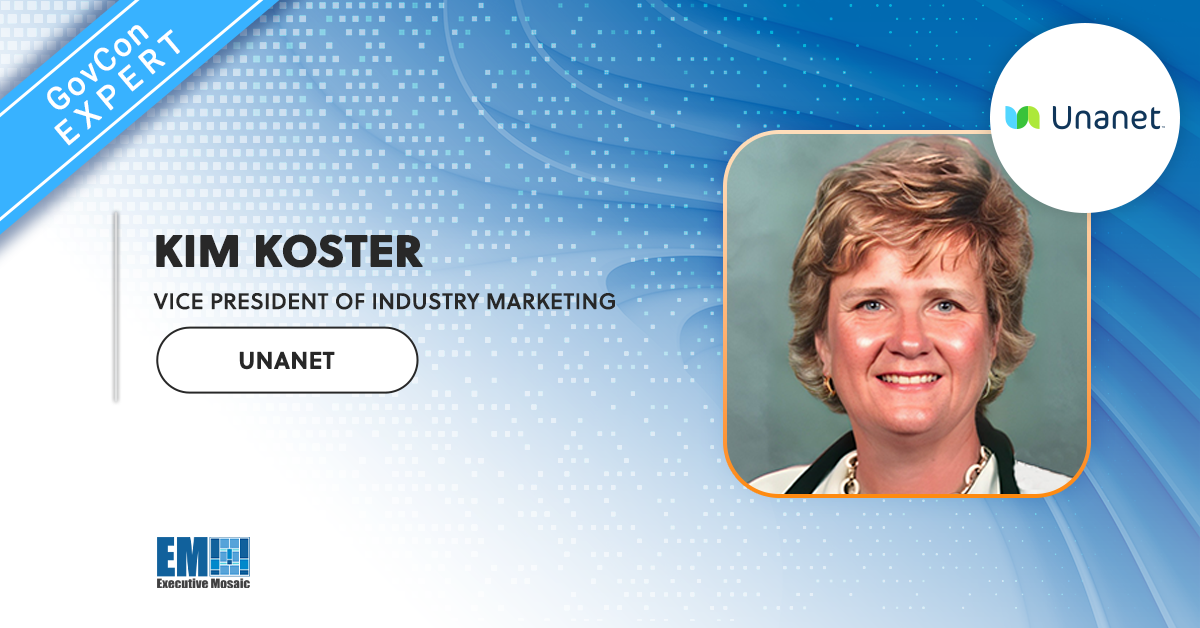Kim Koster, vice president of GovCon Strategy at Unanet, co-author of the 2020 GAUGE Report and GovCon Expert, has published her latest article as a member of Executive Mosaic’s GovCon Expert program on Thursday. GovCon Expert Koster provides insight into the Gauge Report’s findings that explore the best practices and benchmarks of the government contracting (GovCon) world each year.
The 2020 report gathered its data from a pool of nearly 1,500 government officials that provided a variety of perspectives, highlighting the significant impact that COVID-19 pandemic has had on the GovCon sector in 2020. You can read the full 2020 Gauge Report, written by Koster of Unanet and Christine Williamson, partner of CohnReznick, right here. You can read Kim Koster’s GovCon Expert article on the report below:
GAUGE the State of Your GovCon Business
2020 report illuminates the benchmarks, best practices and tech trends that are providing government contractors with a pathway forward in uncertain times.
By Kim Koster
Even for organizations accustomed to the pressurized world of government contracting, 2020 has provided more than its fair share of stressors, adversity and, certainly, unexpected twists.
Take all the new, often unforeseen and at times extraordinary developments brought on by the Covid-19 pandemic (quarantine, virtual working, supply chain disruption, contractual uncertainty and at the most macro level, sky-high unemployment and a looming recession), add other novel stressors such as CMMC compliance and social unrest, along with more familiar competitive challenges like growing annual profits, dealing with tech disruptors and navigating a high level of regulatory and policy uncertainty, and the result is an unprecedentedly pressurized environment for government contractors.
If findings from the newly released 2020 GAUGE Report from Unanet and CohnReznick are any indication, government contractors are indeed feeling pressure from multiple directions — and many are finding creative ways to respond.
“The year 2020 continues to be a season of reckoning,” the report authors (of which I am one — full disclosure) observe, “as government contractors are either reaping the rewards of having laid a sound business and technology foundation, or paying the price of playing catch-up.”
Released in August, the fourth edition of the annual GAUGE Report draws its findings from a survey of more than 1,450 government contractors, spanning a wide range of company sizes, types and industries across the United States.
The survey data yields a series of compelling storylines, performance metrics and business practices that are shaping what today can best be described as a volatile government contracting landscape. Amid so much flux, one thing is certain: There is much to gain by benchmarking your organization against its competitors and by learning how other government contractors are confronting challenges and opportunities similar to yours.
Here’s a glimpse of some of the key findings from the 2020 GAUGE Report, including a revealing before-after look at how the pandemic has shifted organizational mindset:
Covid-19 dims outlook. “Nothing we’ve seen in recent history,” the report states, “[has] had such deep, course-altering impact on all industries, including government contracting, as the novel Covid-19 pandemic.”
The pandemic clearly has dampened government contractors’ overall business outlook. Asked before the pandemic hit in March to characterize the current business environment, 84% of survey respondents said they were either very optimistic or cautiously optimistic. Another 11% were neutral. Asked the same question in the latter part of March, after the pandemic hit, the share of respondents expressing optimism dropped to 68%, while the share who said their business outlook is neutral rose to 21%.

Meanwhile, the share of government contractors expressing a pessimistic outlook doubled, from 5.5% prior to the pandemic to 11% once the Covid-19 crisis hit. “With the stock market volatility and Covid-19 infection rates on the rise, this was not surprising,” the report authors write. “Major contractors of >$50M looked slightly more favorable because of cash reserves and variety of contracts held.”
Pressing issues. Asked to identify the issues that most concern their organization, the cost of compliance topped the list, with 30% of respondents identifying it as their most pressing concern. That’s double the 15% share that named compliance cost as their top concern in the 2018 GAUGE Report. “This is not surprising as Business Systems, CMMC, and FAR compliance is so key to winning new awards,” the report says.
A lack of qualified talent, along with budget and funding constraints, were also high on the list of organizational concerns, although the share of organizations naming fiscal constraints as a top concern has decreased by nearly half since 2018, from 50% to less than 30%.
What issues keep organizational leaders up at night? Operational efficiency topped the list of sleep-spoilers, followed closely by increasing competition for contracts, then resource recruiting and retention. Those issues certainly bear further watching as the pandemic persists and the government contracting sector begins to adjust to the next normal, whatever that ultimately looks like.
Project management improvement. Companies clearly believe they are getting better at managing projects. Close to six in 10 respondents — 59% — reported that 76 to 100% of their projects as being on or under budget, an improvement over prior years.
Resource management and ERP. Asked to assess their company’s resource management practice, 55% of respondents rated theirs at a high level of maturity, an increase from previous years. But that comes with a caveat: “Many companies [still] are using spreadsheets and manual processes for resource management,” notes the report.
For many government contractors, that level of maturity is dictated by the extent to which they have embraced enterprise resource planning (ERP) tools. Slightly more than half —53% — of the government contractors we surveyed indicated they use a project-based ERP software system. Another 18% said they rely on an entry level system. Almost one-third (29%) rely on other generic ERP tools.
Tech shortcomings. The continuing reliance on spreadsheets for the four key PREP functions —pipeline, resource management, estimating and purchasing — points to a broader and ongoing technological deficiency among many government contracting organizations. The 2020 GAUGE Report finds that spreadsheets remain the technology of choice for PREP, a potentially risky reliance in light of current circumstances, according to the report, which notes that “as workers are forced to work remotely for an extended period of time, and as the pressure mounts to squeeze every ounce of efficiency out of their operations, companies may soon collide with the limitations of trying to push spreadsheets to replicate what project-based software can deliver.”
Tech opportunities. Organizations may be missing an opportunity to leverage technology as a competitive differentiator, the GAUGE Report finds. “By this point, most government contractors use technology to help run their businesses. However, only a few are using it to run their businesses better.”
The report illustrates the distinction with an example. Automating the timekeeping process to shave minutes off each employees’ time entry task, and hours off of the task of billing subcontractors, is an example of using technology to run the business. Taking that a step or two further by providing mobile timekeeping and linking actual time spent to a resource planning tool in order to generate richer insights into people and projects is an example of using technology to run the business better.
If government contractors are to take away one message from the 2020 GAUGE Report, it is that their success going forward in such a pressurized business environment depends on them “empowering teams to be productive in any setting and adapting quickly to new ways of operating.”
Technology can enable them to do exactly that.

Kim Koster is Vice President of GovCon Strategy for Unanet, a leader in ERP software purpose-built for government contractors. She focuses on project management, accounting and government contracting.






